A meeting agenda is a document that includes a list of discussion points, measures, and tasks to be addressed in a meeting.
It should include a detailed overview of what should occur during the meeting, who is responsible for each item, and the timeframe for each discussion topic or task. A meeting agenda can also be used to document the meeting and highlight the results or conclusion of subject topics for future reference.
The primary purpose of a meeting agenda is to help structure a meeting properly by establishing clear goals and a framework for discussion. Having this information before and during the meeting helps attendees understand the purpose of the meeting and the range of subjects that will be covered.
There are two types of agendas: informal and formal. An informal meeting agenda would consist of a bulleted list of topics to be discussed. In contrast, a formal meeting agenda would include details about what would be discussed and how each topic would be addressed. Each item on a formal meeting agenda can include time frames and speakers.
To ensure the timely completion of one-off projects and continuing operations, high-performing businesses employ meeting programs to keep meetings on track. So, if you are in a management position, keep reading this guide on creating a meeting agenda to boost productivity and efficiency.
Who Is Responsible for Creating a Meeting Agenda?
A meeting facilitator is the elected team member who takes the initiative to create a meeting agenda, gather necessary information, and invite those who should attend. Successful meeting facilitators design agendas that are easy to follow, address the meeting’s objectives, and avoid topics that lack natural progression.
Pro-tip: As a meeting leader, when creating a meeting agenda, you should prioritize more involvement by inviting all team members to contribute topics before the meeting. Also, to ensure that everyone at the meeting is active, you can give “ownership” of each section of the meeting agenda to different team members.
Why Is It Important to Have a Meeting Agenda?
Meetings are essential to a company’s success, and without a tool to plan the meeting, its objective may not be attained. Below are some reasons why having a meeting agenda is important:
Gives the meeting a clear purpose
For any successful meeting, it is crucial to have a well-thought-out agenda. This clarifies the meeting’s goals and assigns responsibilities to each participant. A meeting’s success is greatly hindered when its attendees are unsure of its purpose. Having an agenda for a meeting helps everyone stay on topic and not wander off subject. The agenda serves this function by outlining the meeting’s intended outcomes and key takeaways.
Allows you to manage time
A meeting agenda enables you to set a timeframe for each agenda item, which is important for optimizing productivity. This can help you plan your meetings effectively, allow direct participants to focus on crucial points, and ensure that allotted topic times are not exceeded.
Ensures all essential topics are covered
Before finalizing the meeting schedule, it is necessary to solicit input from team members on agenda items or areas in which they have questions. With this method, you can be confident that everyone attending is learning something from the discussion.
Clarifies expectations and responsibilities
An inclusive meeting agenda lets contributing team members prepare for a topic, get clarifications on poorly understood topics, and reinforce specific responsibilities across the team.
Allows you to stay on track and avoid distractions
A meeting agenda aids in focusing on the discussed subject, which keeps everyone engaged and reduces distractions. This reduction in distractions can help enhance clear communication of meeting goals and improve the overall efficiency of the meeting.
Empowers everyone to contribute
Thanks to the meeting’s well-defined agenda, all attendees are aware of their obligations. This ensures that everyone has an equal opportunity to contribute insightful comments to the conversation.
Creates a single source of truth for decisions
The agenda also includes a summary of the team meeting for future reference. Additionally, it is ideal for archiving records and responsibilities for future reference.
How to Create a Meeting Agenda: 6 Essential Steps
The success of your meeting largely depends on your ability to convey its objective, provide adequate time for attendees to prepare for the topics at hand, and keep everyone on track.
Continue reading the following steps to create an agenda before your next meeting:
Step 1: Establish the meeting type
No matter what information you want to convey, participants should be informed of what type of meeting they will be attending. This information will aid in their preparation and anticipation of the meeting. Below are key pointers that will help you, the facilitator, know the type of meeting to establish:
- What is the purpose of the meeting being called?
- Is the meeting for generating ideas, or is it a decision-making meeting?
- Who are the participants?
- Is it remote or in-person?
- What should we do next?
Meeting types can be based on formality, purpose, legality, and membership; however, while every meeting is unique, familiarity with the following types can help you choose the ideal objectives, organization, and tasks for them:
Team Meeting
A team meeting involves a group of people who have agreed to meet at a predetermined time to discuss a predetermined set of subjects, which will be laid out in an agenda established by the facilitator. In an ideal situation, a team meeting will help to bring everyone on board with the company’s goals, minimize roadblocks to growth, and provide a safe space for open communication.
Board Meeting
A board meeting is a formal type of meeting that members of the board of an organization and any guest hold at predetermined intervals to assess performance, deliberate policy issues, and resolve pending problems.
Feedback Meeting
A feedback meeting is a meeting type that aims to get valuable insight from team members about current projects or operations.
Executive Session
A private session within a public meeting, such as a board meeting, is known as an executive session. Boards may convene executive sessions to discuss sensitive information with only board members.
Brainstorming Meeting
A brainstorming meeting is where team members analyze, design, explain, and write down ideas for solving issues or creating something new.
Recurring Meeting
A recurrent meeting is a meeting that occurs repeatedly, and the frequency of these meetings may be daily, weekly, monthly, bimonthly, or longer. Whether it’s a team meeting or a recurring project check-in, these meetings are essential for fostering consistency and responsibility.
Other meeting types may include:
- Project kickoff meeting
- Agile meeting
- Committee meeting
- Retrospective meeting
- Onboarding meeting
Step 2: Identify the objective and goal of the meeting
When identifying meeting objectives, you should state what it is you hope everyone on the team will be able to accomplish by the end of the meeting. Using the SMART goal-setting framework will help you organize your objectives appropriately.
When you begin with a goal in mind, you can guarantee that everyone in the meeting is on the same page and that everything you plan to discuss is pertinent to reaching that goal. The success of your meeting will depend on your ability to define and maintain a realistic goal. If you can help the group focus on its purpose, you can expect to get more done in less time.
Step 3: Make a list of discussion topics you want to cover
Once you know why you are holding this meeting, you can begin planning the agenda for what topics will be discussed. Naturally, the goals of your meeting will dictate the discussions that should be included on the agenda. Participant involvement during the meeting may be maximized by soliciting their thoughts and ideas in advance. With everyone’s suggestions, you can choose which ones to implement on your agenda.
Post-meeting question suggestions guarantee you are fostering communication and efficient collection of all the information you need for each agenda topic.
Pro-tip: The success of every team meeting relies on participants having an opportunity to express themselves. To do this, have your group fill in various sections of the meeting agenda with their discussion ideas under each heading over the week. This not only guarantees that everyone on the team contributes to the meeting but also that it is as effective as possible. Participants will arrive with thoughts, questions, and considerations since they are already familiar with the topics to be discussed and the tasks to be completed.
Step 4: Identify the purpose of each task
When developing a meeting agenda, specifying the purpose of each activity helps attendees understand how the activity contributes to meeting goals and objectives. This promotes team engagement and eliminates ambiguity and miscommunication during the meeting.
Step 5: Allocate time to discuss each topic
It’s crucial to schedule a certain amount of time for each meeting topic and anticipate how much time you will need to cover it. To make the most of the allotted time, prioritize the most critical issues for discussion and move them to the front of the agenda.
To make the meeting concise, urge a rapid conclusion if necessary, and keep the meeting on schedule; if you have numerous people attending, you can even limit the time allocated to particular issues.
Pro-tip: Using a meeting management application allows you to not only see how much time is remaining in the meeting but also to check off the talking points as you discuss them, as well as to make notes regarding questions and comments from the team. Using a consensus agenda is another method for reducing meeting duration. Consensus agendas condense recurring conversational topics into a single, checkable item.
Step 6: Include a list of support documents
One efficient technique in creating a meeting agenda is distributing all relevant documents and resources in advance to meeting participants. This approach ensures that everyone has a chance to participate in the meeting and sets the stage for productive conversation.
Support materials provide the information that participants need to engage in fruitful debate, whether in the form of links to specific websites, graphs, charts, or photographs.
Pro-tip: If you want people to come to the meeting prepared with questions and ideas, be sure to provide relevant links, papers, and images.
Step 7: Final review
Allotting a few minutes after every meeting for a quick recap can assist everyone involved in remembering the decisions taken and the points discussed, making it easier to move forward with the next steps. You and other meeting participants should use this review period to reflect on its successes and areas for growth.
Ensure that everything that was decided upon and the steps needed to be taken to implement these decisions are highlighted in the agenda. This will help you maintain order and give you and your team a reference point to retrieve relevant meeting information anytime.
Pro-tip: Both positive and constructive feedback can be helpful, and the best outcomes usually result from a combination of the two. The responses to this assessment will be used to guide future strategic choices. High-performing companies constantly evolve because managers look for feedback through a well-structured meeting agenda.
Meeting Agenda Example
Below is an example that can guide you in writing your meeting agenda:
Crystal Design Solutions Marketing Project Meeting Template
Date: 10/09/2021
Time: 10:00am-11:30pm
Attendees: John Snow, Raina Deneareyes, Daemon, Susan, Princess Amarachi, etc.
Purpose: Evaluation of Marketing Software Tools
Updates(15 mins presentation by John Snow)
- Software Performance in the Last Quarter
- Total Costing Inquired
- Key Performance Indicators
- Profit growth
Drawbacks(15 mins presentation by Susan)
- Discuss any challenges
- Acknowledge concerns raised by participants
Next Steps(15 mins presentation by the facilitator)
- Open Discussions, any idea is welcomed
- List Ideas Here
Improve on The Best Ideas(15 mins presentation by the facilitator)
- Analyze and vote on the Best Ideas
Feedback (15 mins)
- Did this meeting serve its purpose?
- Did you see lapses in presentations?
- Do you understand the value of the marketing software tool to this company?
Post-Meeting Notes(15 mins)
- Document any learnings from the meeting
Meeting Agenda Templates
Meeting agenda templates are an obvious necessity when discussing the value of meetings. Using a template helps shorten the time it takes to create a high-quality agenda which is valuable in getting everyone on the same page and keeping everyone on track as the meeting progresses.
In addition to saving time, having everyone use the same template means they’ll quickly get familiar with its layout and content and can thus anticipate what to expect in the meeting’s logistics.
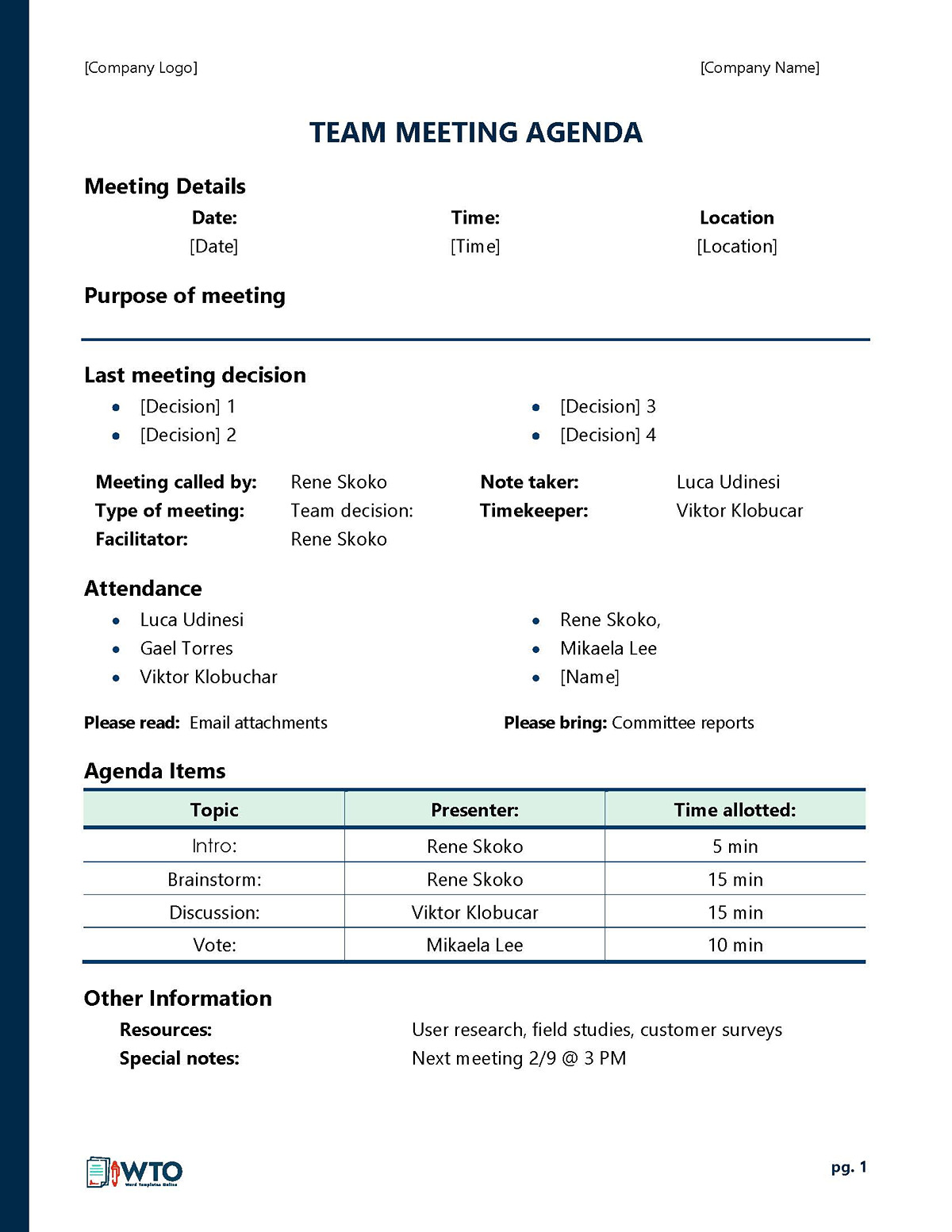
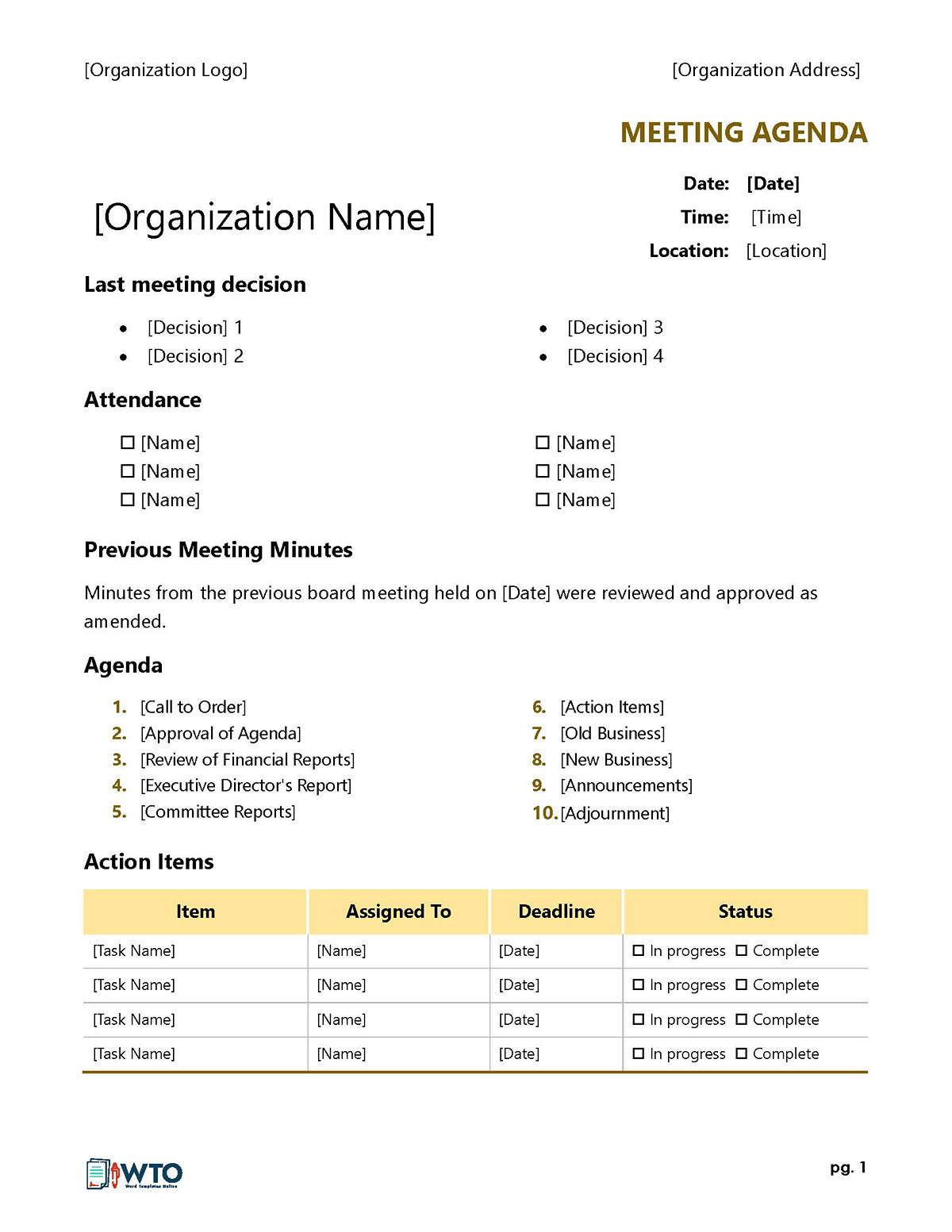
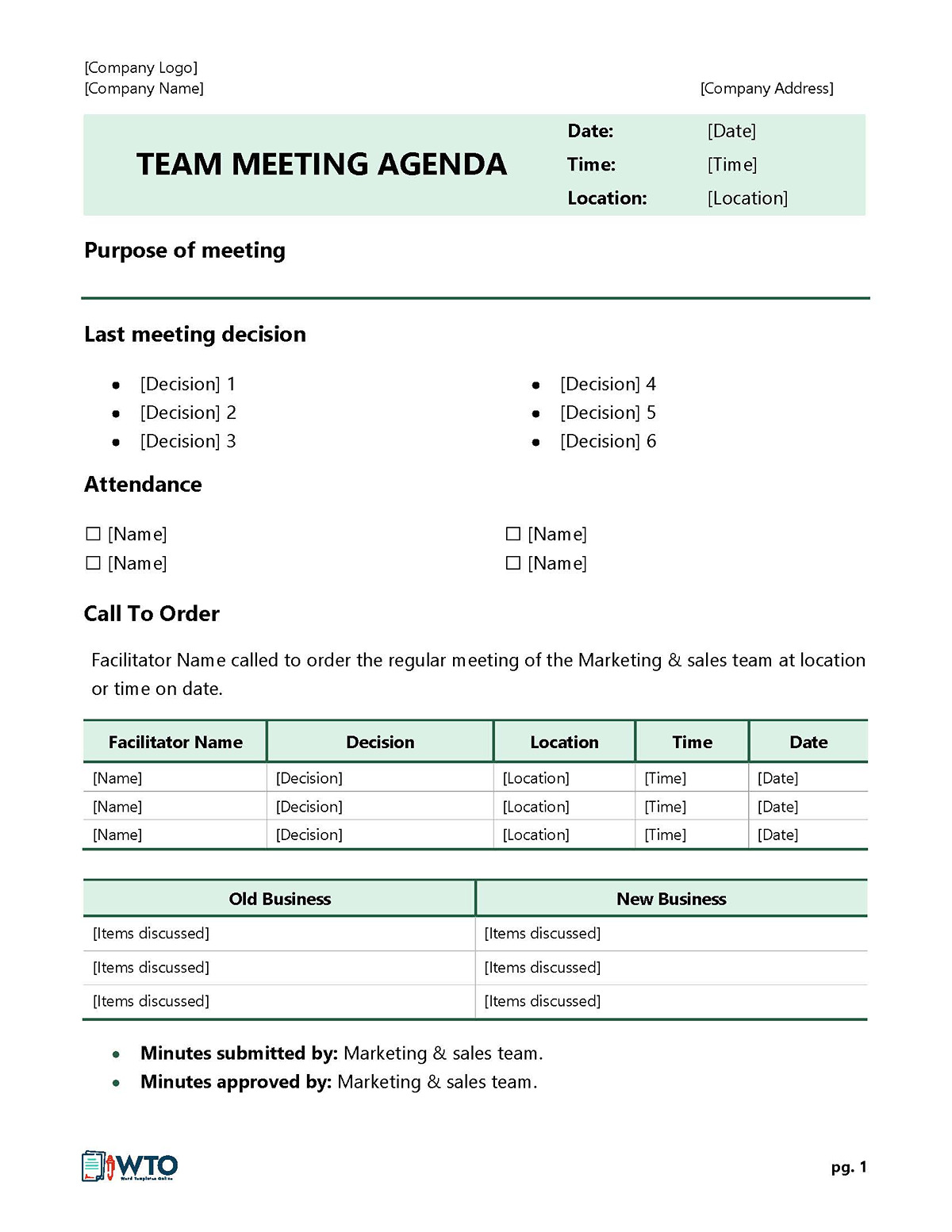

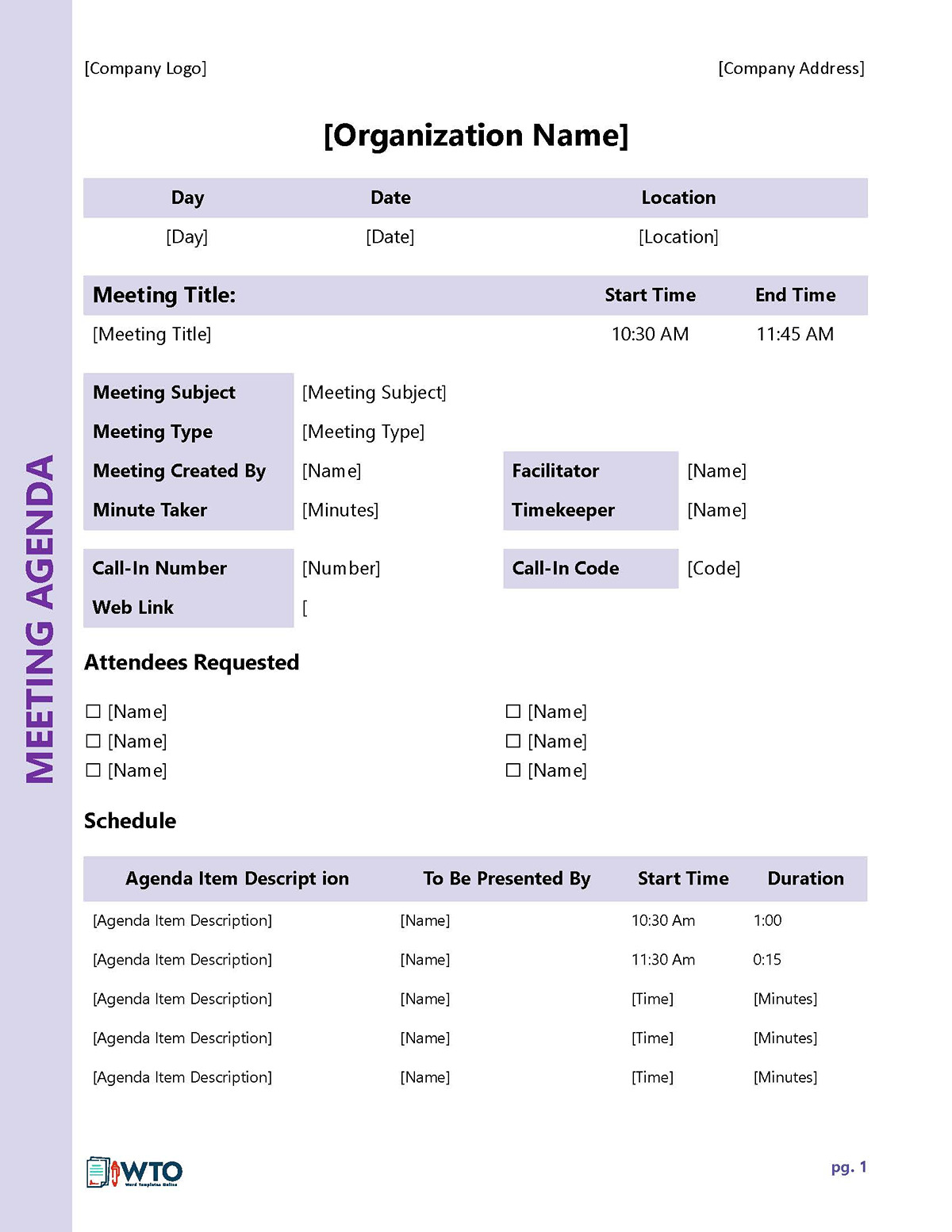
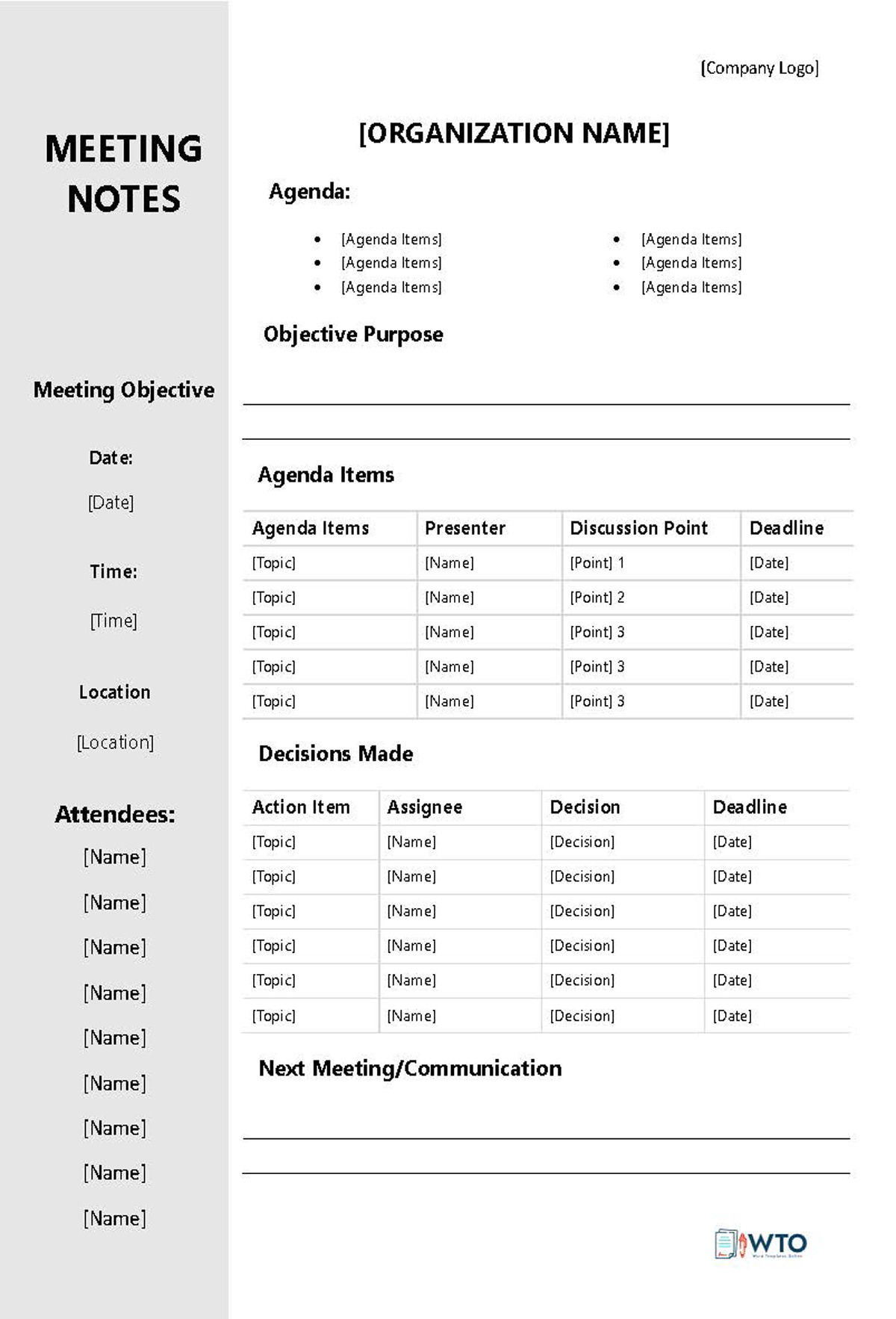

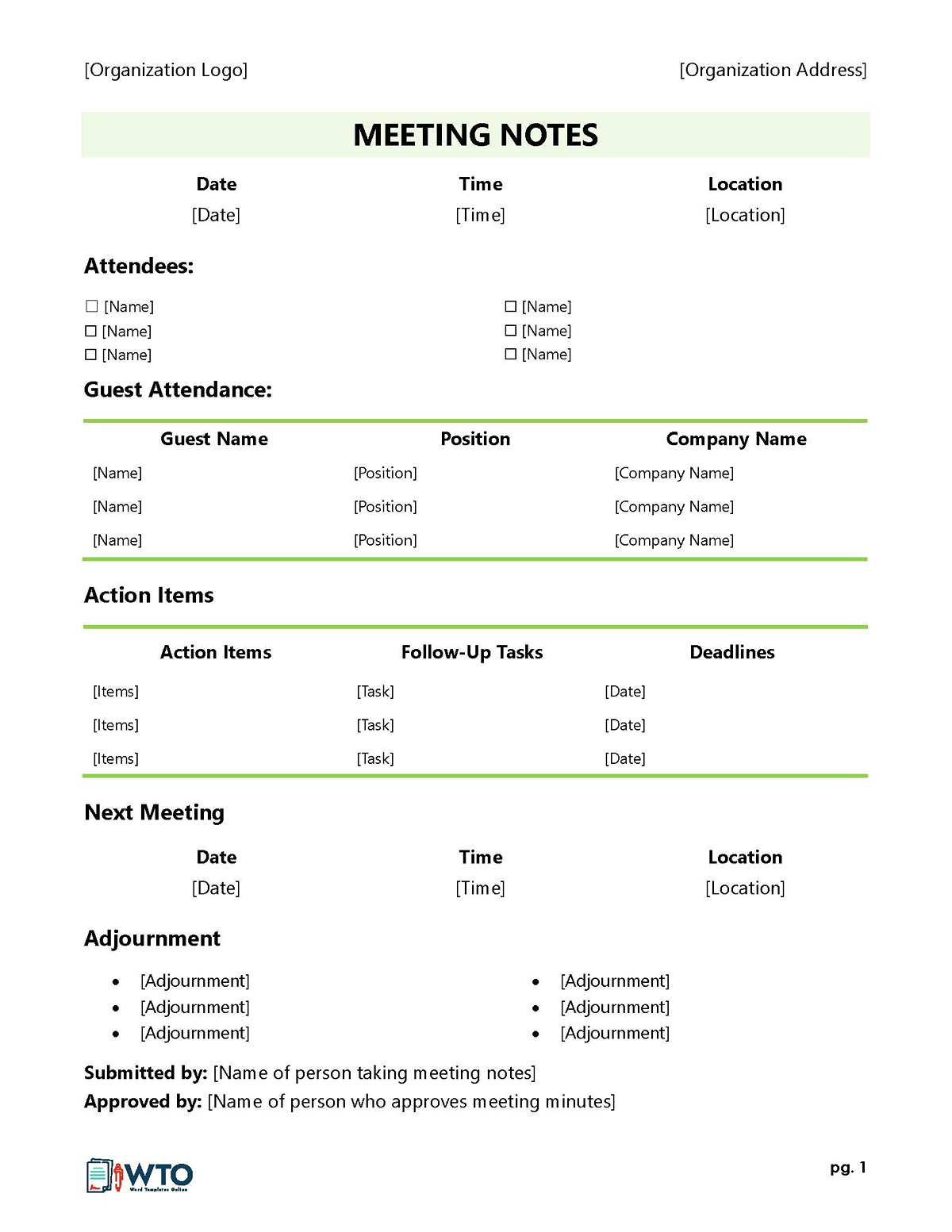
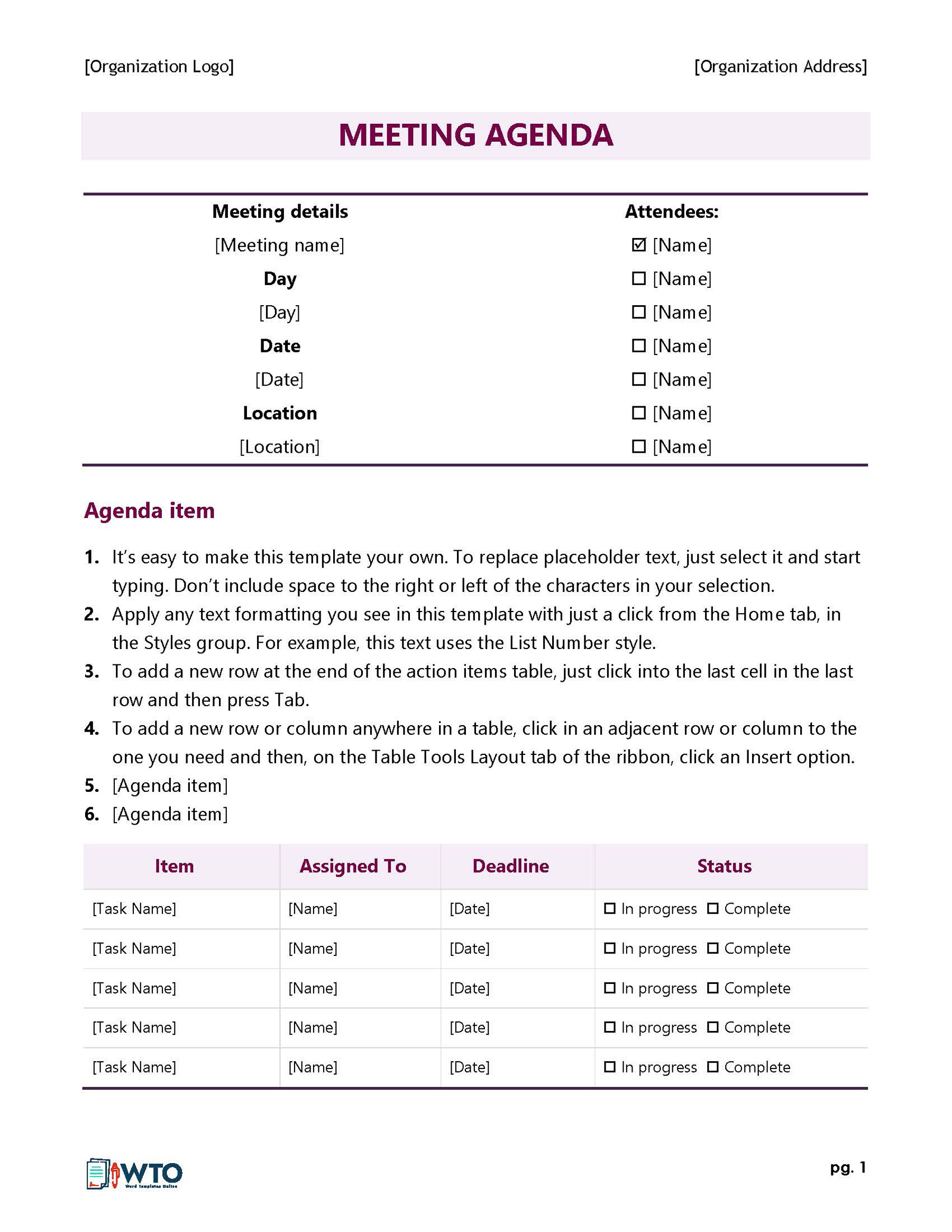

Special Considerations
The purpose of each meeting can be reduced to a list of action items, and those items can be easily accomplished with the help of a well-crafted agenda. This agenda aids in preparation, time management, unifying the group on a single theme, and determining when to wrap up a meeting.
Here are some more suggestions for creating an efficient agenda for your future meeting:
Create a template with headings
Meeting agendas need to have clear titles that convey the purpose of the meeting. A header or title is crucial if you want staff members to grasp meeting purposes quickly. The meeting’s location, date, time, and contact details should be included in the template’s headline.
Identify who leads each topic
To get meeting attendees to be aware of specific responsibilities, it is essential to designate who leads a presentation or discussion on a particular topic. You should include the speaker’s name next to the meeting agenda item they are responsible for leading to make sure they are aware of their role and have adequate time to prepare.
Stay relevant
Meetings with multiple participants should only be called if the topics discussed are relevant to all of them. Take anything off the agenda and schedule a one-on-one meeting with that person; if there’s something you want to talk about only they can answer. You need to consider whose judgments or recommendations are vital for the meeting and who among the attendees will be directly affected.
Be clear about the meeting’s point
Establishing clear meeting points informs participants of the agenda and ensures all issues are addressed. If clear boundaries and expectations are set in advance, meetings are less likely to deviate from their original purpose.
Record action items
Keeping track of the activities planned for a meeting is an excellent method to guarantee that you and your team will be able to achieve your goals. Include in the agenda who on the team will be accountable for each action item and when it will be completed.
Double-check for grammar errors
The final step in creating your meeting agenda is proofreading, which involves looking for apparent issues such as typos and grammatical faults.
Key Takeaways
- An agenda for a meeting is a document that outlines the nature of the meeting, its purpose, the particular roles of attendees, the amount of time allowed for each agenda item, and the meeting’s structure.
- An excellent agenda boosts the overall efficiency of a meeting since it specifies what must occur before, during, and after the meeting. It aids in helping team members know the critical subjects and enables them to solve key challenges quickly.
- When creating a meeting agenda, the facilitator should solicit meeting points and ideas from team members to ensure that the participants’ perspectives and concerns are integrated into the agenda.
- Before distribution, a well-structured meeting agenda should establish the meeting type, reflect team members’ input, address topics that affect the entire team, estimate a realistic amount of time for each topic, propose a process for addressing each meeting point, identify who is responsible for leading each topic, and give room for feedback.










